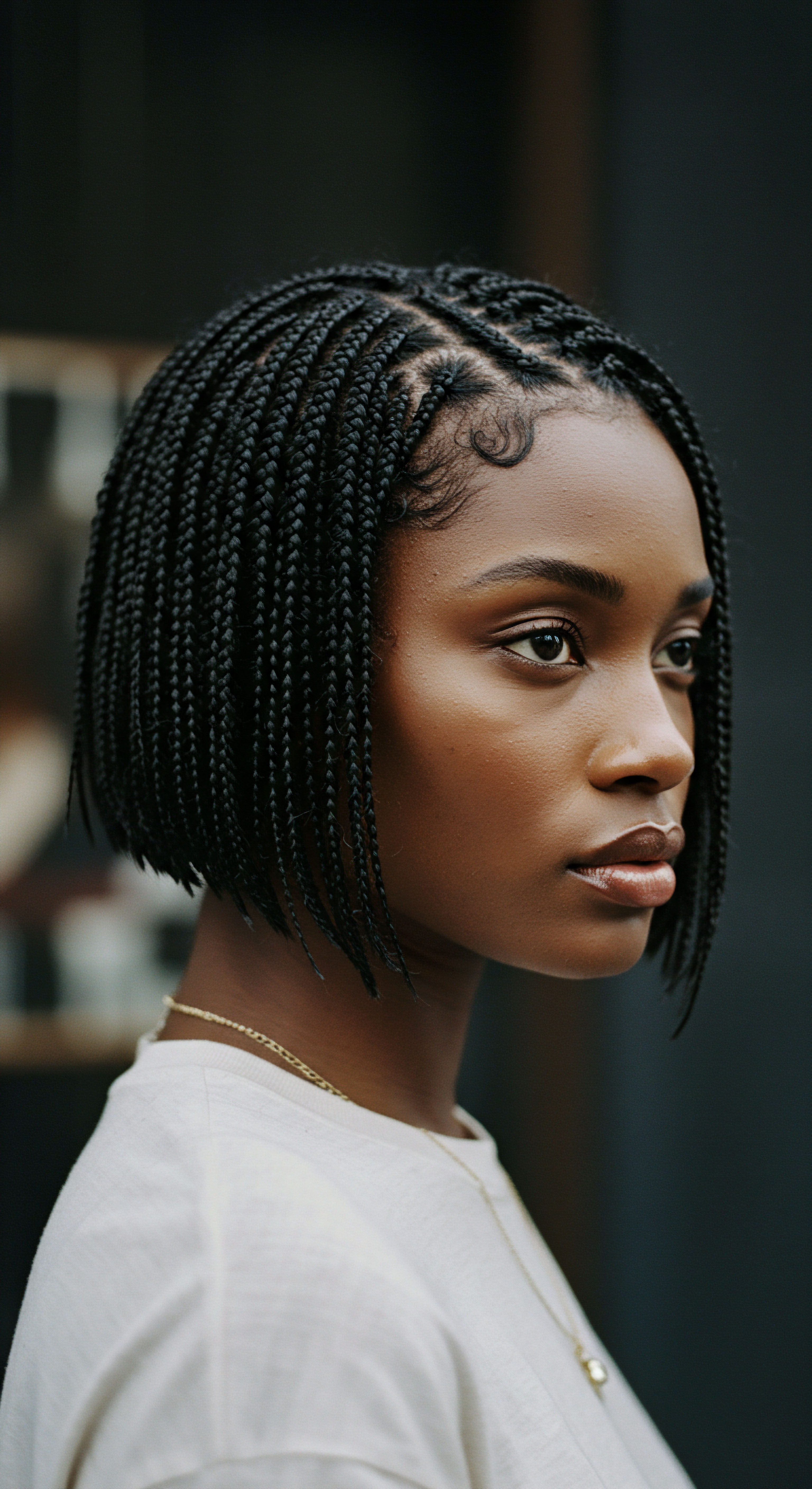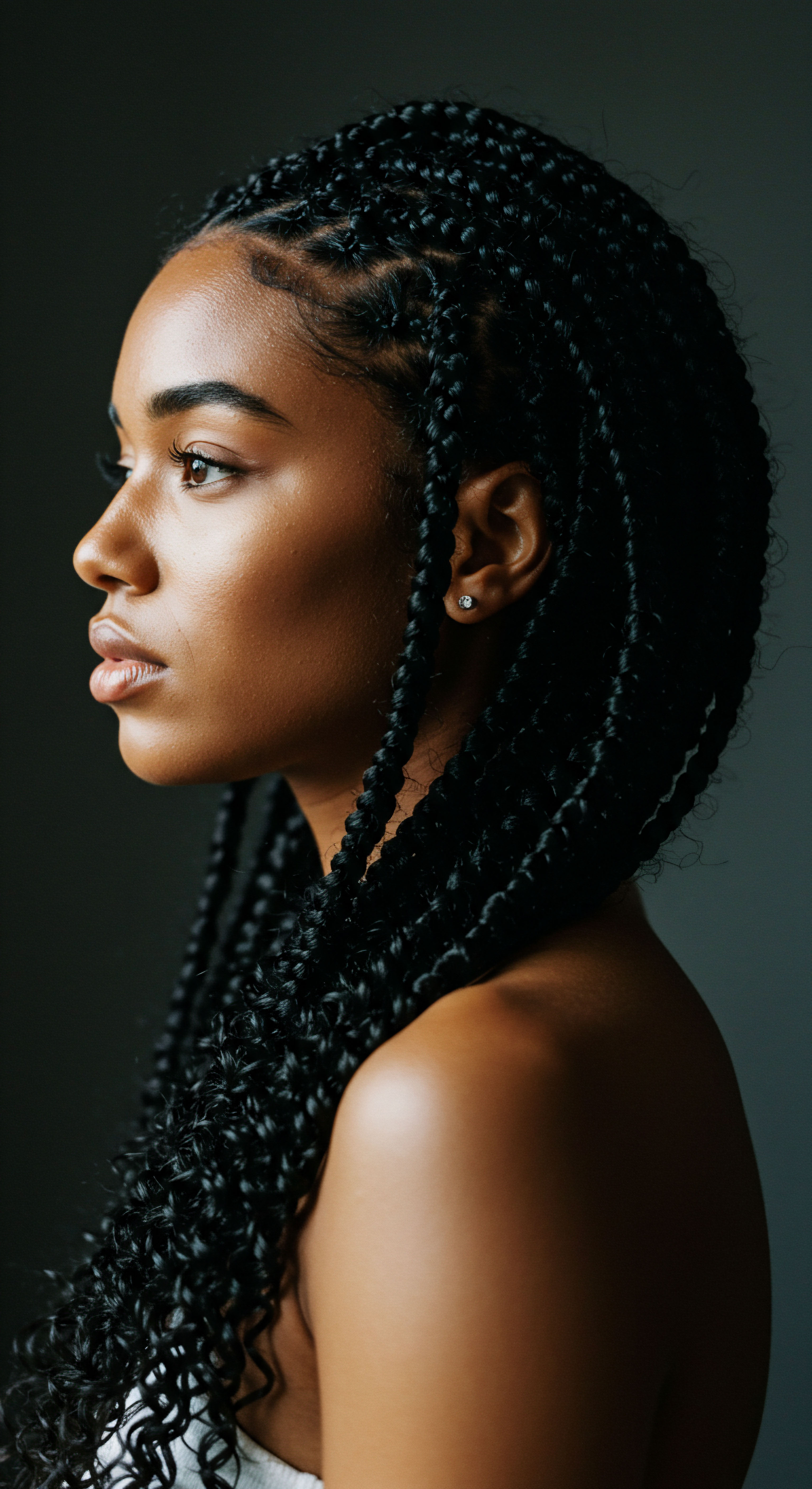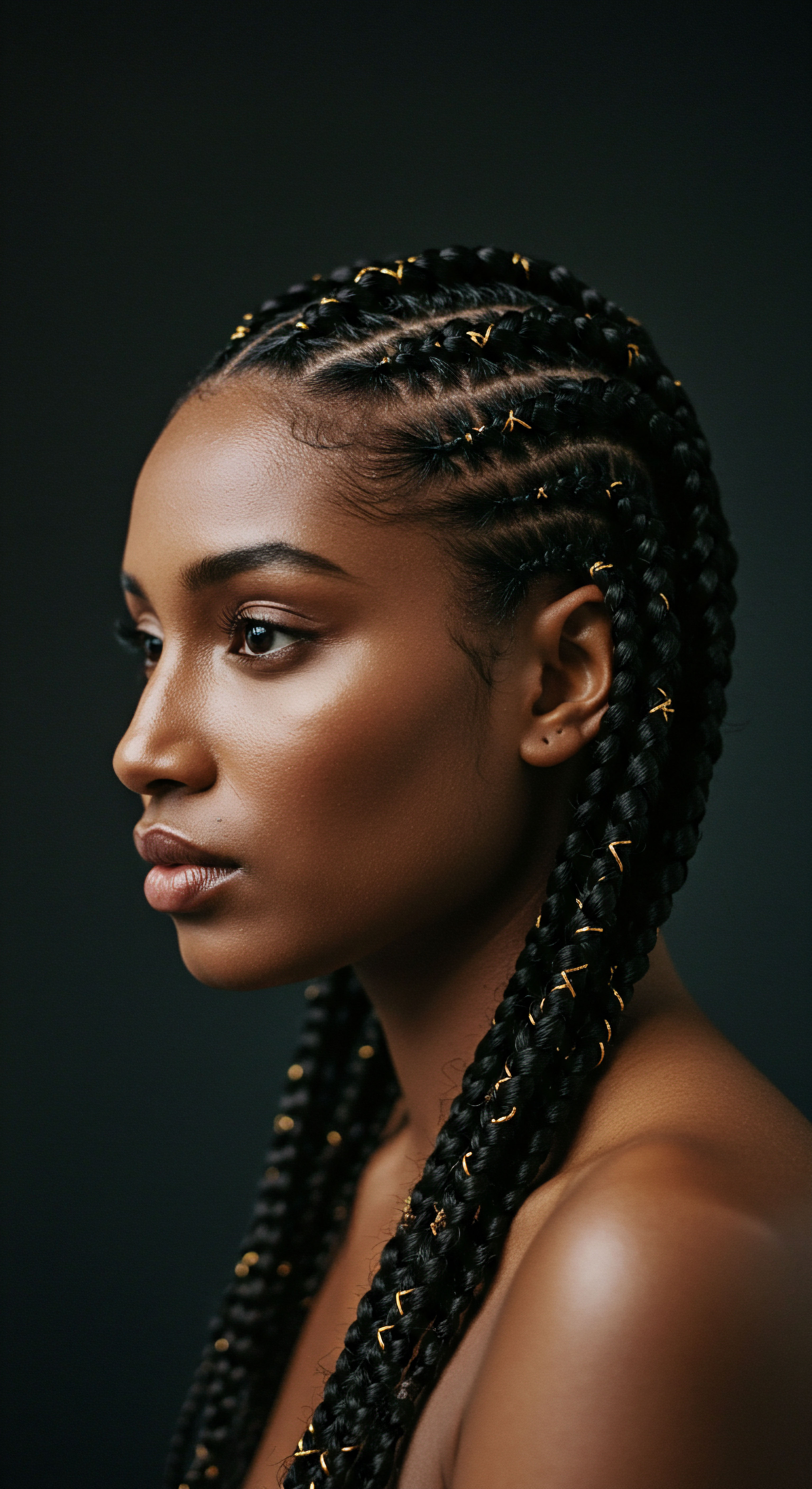
Roots
The whisper of the wind through the leaves, the quiet hum of a city street—these everyday sounds often mask an unseen symphony of elements that settle upon us. Our hair, a crowning glory for many, particularly textured strands with their unique spirals and coils, stands as a delicate receiver in this environmental concert. It is not merely an aesthetic adornment; it serves as a protective layer, a historical record, and a living part of our body. As we move through our days, our scalp, the very ground from which our hair springs, encounters a constant array of atmospheric guests.
The question of whether these environmental pollutants can truly impact the delicate balance of scalp health invites us to look beyond the surface, to understand the intricate interplay between our external world and our internal well-being. This exploration delves into the fundamental science and cultural significance of hair, setting a foundation for understanding how unseen particles might disrupt this harmony.

The Scalp as a Living Ecosystem
Our scalp is a complex ecosystem, a vibrant landscape of skin, hair follicles, sebaceous glands, and a unique microbiome. This intricate system functions as a protective barrier, shielding our delicate inner workings from the outside world. It maintains a specific pH balance, produces sebum to lubricate and protect the hair and skin, and hosts a diverse community of microorganisms that contribute to its overall health.
When this balance is disturbed, a cascade of issues can arise, ranging from irritation and dryness to more persistent conditions. The scalp’s barrier function, a crucial defense mechanism, is particularly vulnerable to external aggressors.
Consider the stratum corneum, the outermost layer of our skin, including the scalp. This layer, often described as a brick-and-mortar structure, consists of corneocytes (the bricks) held together by a lipid matrix (the mortar). This design is purposeful, providing a robust shield against moisture loss and the entry of harmful substances.
When this barrier is compromised, the scalp becomes more permeable, allowing environmental pollutants to penetrate more easily. This increased permeability can lead to heightened sensitivity, discomfort, and a predisposition to inflammatory responses.
The scalp, a living ecosystem, functions as a vital protective barrier, its delicate balance susceptible to external disruptions.

Hair Anatomy and Its Environmental Interface
Hair itself, though seemingly inert, is a dynamic structure that acts as a physical shield and a collection point for environmental elements. Each strand, composed primarily of keratin protein, extends from a follicle embedded within the scalp. The outermost layer of the hair shaft, the cuticle, comprises overlapping scales that protect the inner cortex.
When healthy, these scales lie flat, contributing to shine and smoothness. However, environmental stressors can lift or damage these cuticles, exposing the inner hair and making it more vulnerable.
- Hair Follicle ❉ The tiny organ within the skin where hair growth originates. It is deeply connected to the body’s internal systems, receiving nourishment and signals that influence hair cycles.
- Hair Shaft ❉ The visible part of the hair, extending from the scalp. Its integrity, particularly the cuticle, is crucial for defense against environmental damage.
- Sebaceous Gland ❉ Adjacent to the hair follicle, these glands produce sebum, a natural oil that coats the hair and scalp, providing a layer of protection and moisture.
The surface of our hair, especially textured hair with its varied curl patterns, offers an ample area for particulate matter and other airborne contaminants to settle. This physical accumulation is a primary way pollutants interact with our hair and scalp. These particles, often microscopic, can adhere to the hair shaft and the scalp, initiating a series of reactions that can compromise both hair health and scalp integrity.

Ritual
Stepping into the realm of daily practice, we acknowledge the quiet wisdom that guides our hair care. Our routines, whether passed down through generations or discovered through personal exploration, represent a profound connection to our textured strands. Yet, even within these cherished rituals, an unseen challenge persists ❉ the insidious presence of environmental pollutants.
This section invites us to consider how these unseen elements interact with our care practices and what practical understanding can help us protect our scalp, the very ground of our hair’s vitality. It is a space for gentle guidance, exploring the applied knowledge that allows us to safeguard our hair’s well-being against the subtle, yet persistent, influence of our surroundings.

Particulate Matter and Scalp Irritation
One of the most pervasive environmental pollutants is particulate matter (PM), a mixture of tiny solid particles and liquid droplets suspended in the air. These particles, categorized by size (PM10, PM2.5), originate from sources like vehicle exhaust, industrial emissions, and even natural dust. They are small enough to penetrate skin pores and adhere to the hair and scalp. When these microscopic particles settle, they do not simply sit idly; they initiate a series of biological responses.
The scalp, when exposed to PM, can develop sensitivity, discomfort, dryness, or even increased oiliness. This occurs as pollutants can disrupt the scalp’s delicate barrier function, leading to increased transepidermal water loss (TEWL) and an altered sebum composition. An altered sebum profile, for instance, can result in an overproduction of oils, setting the stage for conditions such as seborrheic dermatitis, which manifests as redness, itching, and flaking.

How Does Particulate Matter Cause Scalp Problems?
Particulate matter carries with it various adsorbed substances, including polycyclic aromatic hydrocarbons (PAHs) and heavy metals. These substances, upon contact with the scalp, can induce the production of reactive oxygen species (ROS). ROS, often called free radicals, are highly reactive molecules that can damage cellular structures, including those within hair follicles and scalp skin.
This oxidative stress can lead to inflammation, a key driver of many scalp issues. Chronic inflammation, left unchecked, can compromise the hair follicle’s ability to function optimally, potentially leading to hair thinning or even loss.
Furthermore, PM can physically clog hair follicles, hindering the natural processes of hair growth and shedding. The accumulation of these pollutants can also disrupt the scalp microbiome, the community of bacteria and fungi that reside on the scalp surface. A balanced microbiome is essential for scalp health, and its disruption can lead to the overgrowth of certain microorganisms, such as Malassezia, a common culprit in dandruff.
Particulate matter from environmental sources can disturb the scalp’s delicate balance, causing oxidative stress and inflammation.

Chemical Exposures and Their Effects
Beyond airborne particles, our scalp and hair are also exposed to chemical pollutants present in water, products, and indoor environments. Chlorinated water, for instance, can strip the hair’s natural oils and damage the cuticle, leaving it more susceptible to further environmental harm. Indoor air quality, often overlooked, can harbor volatile organic compounds (VOCs) released from building materials, furniture, and cleaning products. These VOCs can settle on the scalp, contributing to irritation and sensitivity.

Are Hair Smoothing Products a Hidden Source of Pollutants?
A particularly concerning source of chemical exposure, especially for those with textured hair who may seek certain styling outcomes, comes from some hair smoothing or straightening products. These products, sometimes referred to as keratin treatments, often contain formaldehyde or formaldehyde-releasing chemicals. When heated, as is common during the application process, these chemicals release formaldehyde gas into the air.
Formaldehyde is a known human carcinogen and a potent irritant. Exposure can lead to immediate reactions such as eye and respiratory irritation, headaches, and skin sensitivity, including allergic contact dermatitis on the scalp. Prolonged or repeated exposure has been linked to more serious health concerns, including an increased risk of certain cancers. The scalp, directly exposed to these chemicals, can experience redness, itching, dryness, and even more severe conditions.
| Pollutant Type Particulate Matter (PM2.5, PM10) |
| Sources Vehicle exhaust, industrial emissions, dust |
| Potential Scalp Effects Oxidative stress, inflammation, barrier disruption, hair loss, seborrheic dermatitis, sensitive scalp syndrome |
| Pollutant Type Polycyclic Aromatic Hydrocarbons (PAHs) |
| Sources Combustion processes, adsorbed on PM |
| Potential Scalp Effects Reactive oxygen species production, inflammatory reactions, hair follicle damage, hair loss |
| Pollutant Type Heavy Metals (Lead, Mercury, Nickel, Arsenic) |
| Sources Industrial pollution, vehicle emissions, e-waste |
| Potential Scalp Effects Accumulation in hair, potential toxicity, oxidative stress, hair loss |
| Pollutant Type Volatile Organic Compounds (VOCs) |
| Sources Building materials, cleaning products, some hair products |
| Potential Scalp Effects Scalp irritation, dryness, allergic reactions |
| Pollutant Type Formaldehyde |
| Sources Some hair smoothing/straightening treatments |
| Potential Scalp Effects Contact dermatitis, irritation, redness, itching, long-term health risks |
The impact of these chemical exposures is particularly significant for textured hair, which often possesses unique structural characteristics, such as increased porosity, that can make it more susceptible to damage from harsh chemicals. This vulnerability underscores the importance of mindful product selection and awareness of the ingredients we introduce to our scalp and strands.

Relay
As we journey deeper, the conversation shifts from the observable to the profoundly interconnected. How does the air we breathe, the water we use, and the products we apply truly resonate within the delicate biology of our scalp? This section invites a more discerning gaze, drawing upon scientific inquiry and real-world data to unravel the subtle yet potent ways environmental pollutants interact with our scalp’s intricate systems. It is here that we move beyond surface understanding, exploring the profound interplay of biology, environment, and personal experience, always with the unique beauty of textured hair at the forefront of our consideration.

The Microscopic Battle on the Scalp
The interaction between environmental pollutants and scalp health is not a simple cause-and-effect relationship; it is a complex biological skirmish waged at the cellular level. Particulate matter, particularly the fine particles (PM2.5), possesses the ability to penetrate the outermost layers of the skin, including the scalp, and even infiltrate hair follicles. Once inside, these foreign invaders can trigger a cascade of cellular responses.
One significant mechanism involves the generation of reactive oxygen species (ROS), which leads to oxidative stress. This imbalance between free radicals and the body’s antioxidant defenses can damage cellular components, including DNA, proteins, and lipids, within the hair follicle and surrounding scalp tissue. This damage can disrupt the normal hair growth cycle, leading to premature entry into the resting (telogen) phase and subsequent shedding.
A study presented at the 28th European Academy of Dermatology and Venereology Congress in Madrid brought compelling evidence to light regarding this connection. Researchers exposed human follicle dermal papilla cells (HFDPCs), which are found at the base of hair follicles and are essential for hair growth, to various concentrations of diesel particulate and dust resembling PM10. The findings revealed that higher levels of these pollutants significantly decreased the levels of β-catenin, a protein crucial for hair growth and morphogenesis.
Furthermore, the levels of other proteins vital for hair growth and retention—cyclin D1, cyclin E, and CDK2—also saw a dose-dependent decrease. This scientific observation provides a direct cellular link between common air pollutants and compromised hair growth mechanisms, suggesting that the invisible elements around us actively undermine the very processes that keep our hair healthy and vibrant.

Endocrine Disruptors and Hormonal Balance
Beyond particulate matter, another class of environmental pollutants, endocrine-disrupting chemicals (EDCs), presents a silent challenge to scalp health. EDCs are substances that interfere with the body’s hormonal system, mimicking or blocking natural hormones. These chemicals can be found in various environmental sources, including plastics, pesticides, and, significantly, in some personal care products.
For textured hair communities, a particular concern arises from the historical and ongoing use of certain hair products. Research has shown that hair products marketed towards Black women can contain dozens of hazardous chemicals, including phthalates, parabens, and cyclosiloxanes, many of which are known EDCs. A study published in the journal Environmental Research found that these products often contain between 4 and 30 target endocrine disruptors, with 84% of detected chemicals not listed on the product label.
The implications for scalp health are profound. Hormones play a pivotal role in regulating the hair growth cycle and sebaceous gland activity. Disruptions to this delicate hormonal balance by EDCs can manifest as changes in sebum production, leading to overly oily or dry scalp conditions, and potentially impacting hair growth patterns. While direct links between EDCs in hair products and specific scalp conditions are still under active investigation, the potential for these chemicals to interfere with the body’s endocrine system, which in turn influences hair follicles, warrants serious consideration.
Unseen endocrine-disrupting chemicals in certain hair products pose a quiet challenge to scalp health by interfering with the body’s hormonal systems.

The Scalp Microbiome Under Siege
The scalp is home to a diverse community of microorganisms, collectively known as the scalp microbiome. This microbial ecosystem plays a crucial role in maintaining scalp health, contributing to barrier function and immune responses. Environmental pollutants, however, can disrupt this delicate balance, leading to dysbiosis, an imbalance in the microbial community.
Pollution, alongside other factors like humidity and stress, can alter microbial diversity on the scalp. This alteration can favor the overgrowth of certain species, such as Malassezia fungi, which are commonly associated with dandruff and seborrheic dermatitis. When the scalp barrier is compromised by pollutants, it becomes more vulnerable to these microbial shifts, exacerbating inflammatory responses and leading to persistent scalp discomfort.

Can Pollution Affect Hair Fiber Integrity?
Beyond the scalp itself, pollutants can directly impact the hair fiber. Airborne particles can adhere to the hair surface, making it rougher and duller. These particles can also induce oxidative damage to the hair shaft, particularly the cuticle and cortex. Studies have shown that exposure to cigarette smoke, as a simulated polluted environment, can cause significant chemical damage to hair, leading to increased cuticle irregularity and protein degradation.
The effects extend to the hair’s mechanical properties and appearance. Pollution can strip hair of its natural moisture, rendering it dry, brittle, and more prone to breakage. It can also lead to a loss of melanin pigment, potentially causing premature graying. The cumulative effect of these environmental stressors can significantly compromise the overall quality, strength, and vibrancy of textured hair.
Consider a study conducted in two Chinese cities, Baoding (more polluted) and Dalian (less polluted), where researchers examined the microstructure of hair tips from residents. The images revealed fractures and gaps within the hair cortex, with their relative densities being significantly higher in hair from the more polluted city. This observation suggests a direct physical degradation of the hair fiber due to environmental pollution, amplified by factors like UV exposure. This physical damage makes textured hair, already prone to dryness and breakage, even more vulnerable.
- Oxidative Stress ❉ Pollutants trigger the production of reactive oxygen species, damaging hair follicles and scalp cells.
- Inflammation ❉ Chronic exposure to pollutants can lead to persistent inflammatory responses on the scalp.
- Barrier Dysfunction ❉ Pollutants compromise the scalp’s protective barrier, increasing permeability and sensitivity.
- Microbiome Imbalance ❉ The delicate microbial ecosystem on the scalp can be disrupted, leading to conditions like dandruff.
- Hair Fiber Degradation ❉ Pollutants can directly damage the hair shaft, affecting its strength, moisture, and appearance.

Reflection
As the discourse on environmental pollutants and scalp health unfolds, a deeper appreciation for the resilience of our textured strands emerges. The journey through scientific insights and historical contexts reveals that our hair, particularly its vibrant, coily forms, is not merely a reflection of our genetic blueprint but also a living chronicle of our interactions with the world around us. We are reminded that care for our scalp and hair extends beyond surface-level practices; it calls for a conscious awareness of the unseen forces that influence our well-being.
This understanding empowers us to approach our hair rituals with a renewed sense of purpose, recognizing the profound connection between our personal health and the broader environmental landscape. The path forward invites continued inquiry, gentle adaptation, and a celebration of the enduring spirit of our hair.

References
- Son, E. & Kwon, K. H. (2025). The Invisible Threat to Hair and Scalp from Air Pollution. Polish Journal of Environmental Studies, 34(2), 1745-1753.
- MDPI. (n.d.). Skin and Scalp Health Benefits of a Specific Botanical Extract Blend ❉ Results from a Double-Blind Placebo-Controlled Study in Urban Outdoor Workers. Retrieved from MDPI.
- BlueMagic Group. (2023, June 8). Can Air Pollution Cause Hair Loss? An In-Depth Analysis. Retrieved from BlueMagic Group.
- EADV Congress. (2019, October 8). Air pollution may be causing your hair to fall out. Retrieved from EADV Congress.
- Reddit. (2024, July 23). Environmental toxins are causing hair loss. Retrieved from Reddit.
- Kera Mane. (2024, October 30). The Long-Term Effects of Keratin Treatment Ingredients ❉ What You Need. Retrieved from Kera Mane.
- U.S. Food and Drug Administration. (2021, March 2). Formaldehyde in Hair Smoothing Products ❉ What You Should Know. Retrieved from FDA.
- Capilclinic USA Blog. (n.d.). Formaldehyde to straighten hair ❉ How bad is it? Retrieved from Capilclinic USA Blog.
- Jin, S. P. Li, Z. Choi, E. K. Lee, S. Kim, Y. K. Seo, E. Y. & Chung, J. H. (2018). Particulate Matters Induce Apoptosis in Human Hair Follicular Keratinocytes. Annals of Dermatology, 30(5), 555–562.
- MDPI. (2025, May 16). Scalp Microbiome Explained ❉ What’s Living on Your Scalp and Why It Matters. Retrieved from MDPI.
- Gavazzoni-Dias, M. F. R. Rochael, M. Vilar, E. Tanus, A. & Tosti, A. (2016). Eczema-Like Psoriasiform Skin Reaction due to Brazilian Keratin Treatment. Skin Appendage Disorders, 1(3), 156-162.
- ResearchGate. (2024, November 21). Particulate matter (PM’s) adheres to human hair exposed to severe aerial pollution ❉ Consequences for certain hair surface properties. Retrieved from ResearchGate.
- Respiratory Therapy. (2019, October 9). Air Pollution Linked to Hair Loss. Retrieved from RT – Respiratory Therapy.
- Rajput, R. S. (2015, January). Understanding Hair Loss due to Air Pollution and the Approach to Management. Retrieved from ResearchGate.
- Times of India. (2024, November 28). Protect hair from pollution ❉ A guide to healthy hair. Retrieved from Times of India.
- MDEdge. (2024, December 4). Hidden Risks of Formaldehyde in Hair-Straightening Products. Retrieved from MDEdge.
- Times of India. (2019, October 10). Pollutants in air killing hair follicles; making men go bald. Retrieved from Times of India.
- Zois, C. & Sinopidis, C. (2022). Hormonal Effects on Hair Follicles. MDPI, 12(12), 2200.
- Silent Spring Institute. (2018, April 10). Hair products for Black women contain mix of hazardous ingredients. Retrieved from Silent Spring Institute.
- ResearchGate. (2018, February 1). Pollution Damage and Protection of Asian Hair. Retrieved from ResearchGate.
- Chiang Mai University Journal of Natural Sciences. (2024, September 11). Assessment of Hair Polycyclic Aromatic Hydrocarbons and Their Impact on Respiratory Health and Functional Exercise Capacity in Adolescent Females. Retrieved from Chiang Mai University Journal of Natural Sciences.
- Thomas, C. G. (2023, May 26). Carcinogenic materials in synthetic braids ❉ an unrecognized risk of hair products for Black women. Journal of the National Medical Association.
- trichology. (2024, July 22). Is Pollution Ruining Your Hair? Learn About its Impact on Hair Health. Retrieved from trichology.
- European Parliament. (2019, May 8). New insights on the effects of endocrine-disrupting chemicals on children. Retrieved from European Parliament.
- Langsam, M. (n.d.). Understanding Hair Loss due to Air Pollution and the Approach to Management. Retrieved from Martine Langsam.
- MDPI. (n.d.). The Genomic Variation in Textured Hair ❉ Implications in Developing a Holistic Hair Care Routine. Retrieved from MDPI.
- Harvard T.H. Chan School of Public Health. (2024, June 15). Uncovering the dangers of hair products marketed to Black women, girls. Retrieved from Harvard T.H. Chan School of Public Health.
- European Parliament. (2019, May 8). Endocrine Disruptors ❉ from Scientific Evidence to Human Health Protection. Retrieved from European Parliament.
- MDPI. (n.d.). Characterization of the Toxicological Impact of Heavy Metals on Human Health in Conjunction with Modern Analytical Methods. Retrieved from MDPI.
- NPR. (2024, September 9). Hair and skin care products expose kids to hormone disrupting chemicals, study finds. Retrieved from NPR.
- Helm, J. S. & Zota, A. R. (2021). Hormonal activity in commonly used Black hair care products ❉ evaluating hormone disruption as a plausible contribution to health disparities. Journal of Exposure Science & Environmental Epidemiology, 31(1), 86–96.
- ResearchGate. (n.d.). Redness from scalp irritation and itching caused by pollution. Retrieved from ResearchGate.
- Rahn AG. (2022, April 5). The Invisible Threat for Hair and Scalp. Retrieved from Rahn AG.
- Journal of Cosmetic Science. (2023, January 17). Assessing the effect of cleansing products on artificially polluted human hairs and skin through in vivo and in vitro models. Retrieved from Journal of Cosmetic Science.
- Journal of Drugs in Dermatology. (2022, December 20). Effects of Hormones and Endocrine Disorders on Hair Growth. Retrieved from Journal of Drugs in Dermatology.
- Journal of Drugs in Dermatology. (2025, February 28). A Clinical Evaluation of Scalp Barrier Function, Ceramide Levels, and Microbiome in Diverse Dandruff Patients. Retrieved from JDDonline – Journal of Drugs in Dermatology.
- Pol. J. Environ. Stud. (n.d.). The Invisible Threat to Hair and Scalp from Air Pollution. Retrieved from Pol. J. Environ. Stud.
- Journal of Drugs in Dermatology. (n.d.). Etiology, Treatment Challenges, and the Role of Scalp and Haircare in Managing Dandruff. Retrieved from eScholarship.org.
- ResearchGate. (2003, September 4). Scalp hair analysis as a tool in assessing human exposure to heavy metals (S. Domingos mine, Portugal). Retrieved from ResearchGate.
- Frontiers. (n.d.). Association of mixed polycyclic aromatic hydrocarbons exposure with hearing loss and the mediating role of blood cell markers of inflammation in U.S. adults. Retrieved from Frontiers.
- Polish Journal of Environmental Studies. (2019, December 16). Heavy Metal Accumulation in Dust and Workers’ Scalp Hair as a Bioindicator for Air Pollution from a Steel Factory. Retrieved from Polish Journal of Environmental Studies.
- MDPI. (n.d.). Urinary Polycyclic Aromatic Hydrocarbon Metabolites Are Associated with Biomarkers of Chronic Endocrine Stress, Oxidative Stress, and Inflammation in Adolescents ❉ FLEHS-4 (2016–2020). Retrieved from MDPI.
- PMC. (n.d.). Assessment of Heavy Metal and Trace Element Levels in Patients with Telogen Effluvium. Retrieved from PMC.
- ResearchGate. (2024, September 10). Hair loss due to pollution, micro metabolic dysfunction, epigenetics and role of nutrients. Retrieved from ResearchGate.
- ResearchGate. (n.d.). Use of Scalp Hair As Indicator of Human Exposure to Heavy Metals in an Electronic Waste Recycling Area. Retrieved from ResearchGate.
- Journal of Drugs in Dermatology. (n.d.). Insights on the Impact of Scalp Barrier Condition on Hair Health. Retrieved from JDDonline – Journal of Drugs in Dermatology.